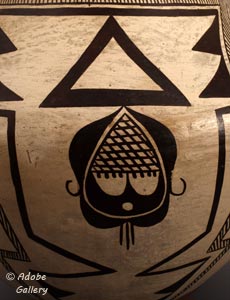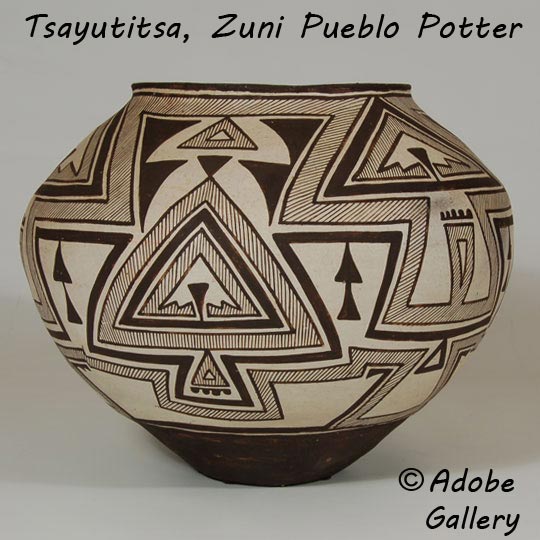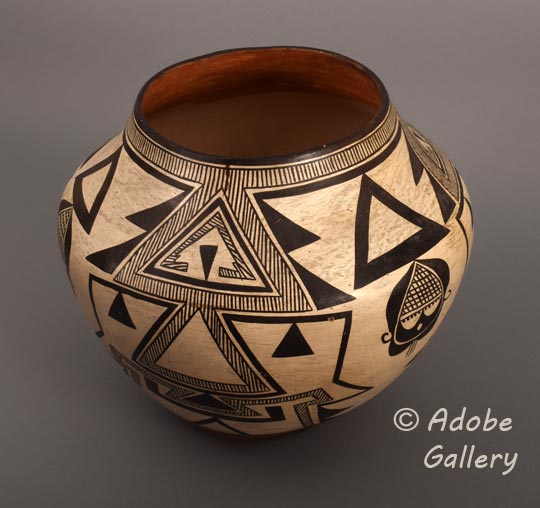Unusual and Unique Magnificent Historic Jar by Mary Histia of Acoma Pueblo
+ Add to my watchlist Forward to Friend
Forward to Friend
- Category: Historic
- Origin: Acoma Pueblo, Haak’u
- Medium: clay, pigment
- Size: 10-½” height x 11-½” diameter
- Item # C4942i
- Price: $19500
 While collectors might initially attribute this striking black-on-black jar to the Zuni master Tsayutitsa (1871-1959), a closer look suggests it is the work of an equally talented Acoma potter, Mary Histia (1895-1973). Though the geometric design of echoing triangles is a signature of Tsayutitsa's style, subtle differences in its execution and the presence of other distinctive motifs point to Histia's hand.
While collectors might initially attribute this striking black-on-black jar to the Zuni master Tsayutitsa (1871-1959), a closer look suggests it is the work of an equally talented Acoma potter, Mary Histia (1895-1973). Though the geometric design of echoing triangles is a signature of Tsayutitsa's style, subtle differences in its execution and the presence of other distinctive motifs point to Histia's hand.
The key to our attribution lies in the specific design elements and artistic techniques. While both potters used black-on-black geometric patterns, there are clear distinctions:
Teardrop and Rain Cloud Motifs: This jar features tear-drop designs surrounded by a gentle rain cloud (see image left), a signature motif of Mary Histia. This particular element is not found in Tsayutitsa's work.
 Triangle Designs: Tsayutitsa's black triangles are typically conjoined, creating an intricate, interconnected pattern. In contrast, the triangles on Histia's jar are single and strategically placed throughout the design, a technique Histia favored. Here is an example of this pattern on a pottery jar by Tsayutitsa of Zuni Pueblo (see image right).
Triangle Designs: Tsayutitsa's black triangles are typically conjoined, creating an intricate, interconnected pattern. In contrast, the triangles on Histia's jar are single and strategically placed throughout the design, a technique Histia favored. Here is an example of this pattern on a pottery jar by Tsayutitsa of Zuni Pueblo (see image right).
Clay and Burnish: There are subtle but noticeable differences in the color and burnish of the white slip used by each artist. Histia's slip has a distinct look that sets it apart. There is no doubt that the Histia jar is of Acoma origin. The underbody clay slip is typically orange, whereas a Zuni underbody is black. This jar has the Acoma color underbody.
The age difference of only 25 years suggests that Tsayutitsa and Histia were contemporaries, possibly aware of or even influencing each other's work. Their active potting periods overlapped significantly from approximately 1915 to 1945. It is more likely that Histia was influenced by Tsayutitsa's work.
The attribution to Mary Histia is supported by abundant documented evidence from scholarly works on Native American pottery:
Dwight P. Lanmon and Francis H. Harlow's The Pottery of Acoma Pueblo: This book provides photographic evidence on pages 380 and 381. An image of one of Histia's well-known NRA (National Recovery Administration) jars clearly shows the same teardrop and face-like symbols present on this jar. Additionally, a large jar with the black-on-white triangle arrangement is also featured, reinforcing the connection.
Rick Dillingham's Acoma & Laguna Pottery: On page 167, a photograph of another of Histia's NRA jars prominently displays the face-like rain cloud symbol, further linking this piece to her unique artistic vocabulary.
Lanman and Harlow's The Pottery of Zuni Pueblo: For comparison, page 439 of this text shows an excellent example of a Tsayutitsa jar from around 1929, which highlights her distinctive echoing black triangle designs and provides a visual contrast to Histia's work.
Based on these stylistic and documented comparisons, it is clear that this jar was made by Mary Histia during the height of her career in the 1920s and 1930s.
We may never know if Histia was honoring Tsayutitsa or was so inspired by her designs that she sought permission to use them. However, what is certain is that both potters were masters of their craft, creating pottery that continues to be celebrated for its artistry and enduring beauty.
Condition: this Unusual and Unique Magnificent Historic Jar by Mary Histia of Acoma Pueblo is in very good condition. There is a small drop of piñon pitch running vertically one inch down from the rim, an indication that the potter probably made an insignificant repair.
References:
- Dillingham, Rick. Acoma & Laguna Pottery, 1992, School of American Research, Santa Fe.
- Lanmon, Dwight P. and Francis H. Harlow. The Pottery of Acoma Pueblo 2013, Museum of New Mexico Press, Santa Fe.
- Lanmon, Dwight P. and Francis H. Harlow. The Pottery of Zuni Pueblo 2008, Museum of New Mexico Press, Santa Fe.

- Category: Historic
- Origin: Acoma Pueblo, Haak’u
- Medium: clay, pigment
- Size: 10-½” height x 11-½” diameter
- Item # C4942i
- Price: $19500
Adobe Gallery Recommended Reading
Adobe Gallery Recommended Items
If you are interested in this item, we would also like to recommend these other related items:



